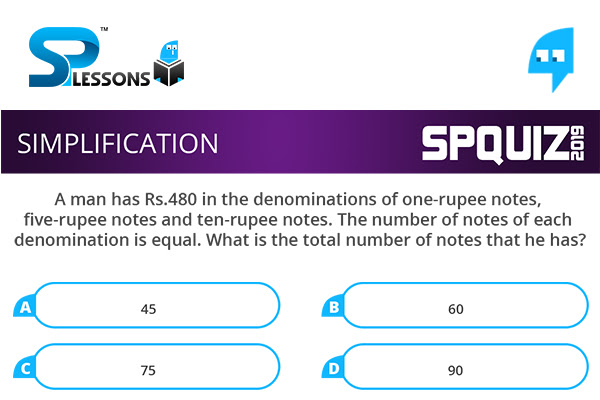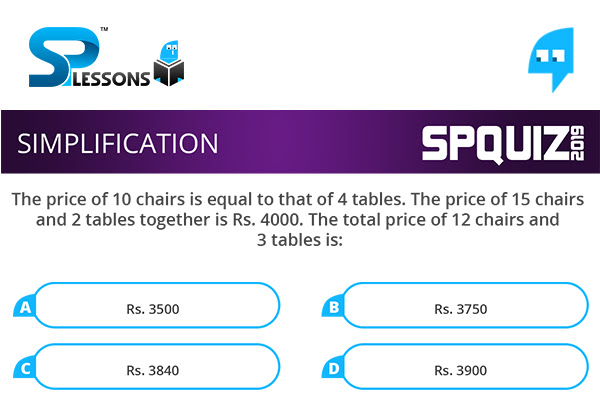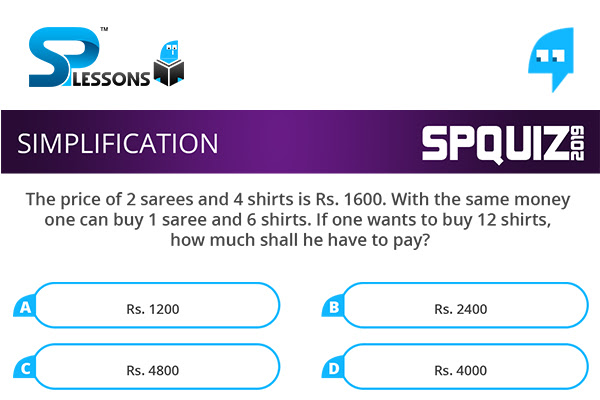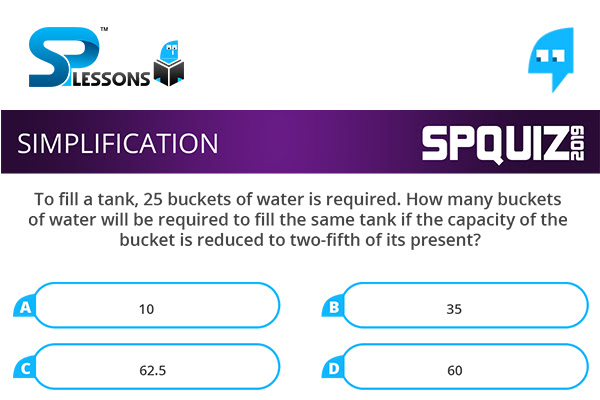 Introduction
Introduction
What is Quantitative Aptitude test?
Quantitative Aptitude is one of the prominent competitive aptitude subjects which evaluates numerical ability and problem solving skills of candidates. This test forms the major part of a number of important entrance and recruitment exams for different fields. The Quantitative Aptitude section primarily has questions related to the Simplification, Numbering Series, and Compound Interest, etc.
What is Simplification?
Simplification is the most widely asked topic in almost every competitive exam. Simplification is based on basic math calculations and some other algebraic topics. Simplification is less time consuming and having higher accuracy.
Simplification Problems is based on BODMAS rule, where
- B → Brackets,
O → Of,
D → Division,
M → Multiplication,
A → Addition, and
S → Subtraction.
 Q1
Q1
A man has Rs.480 in the denominations of one-rupee notes, five-rupee notes and ten-rupee notes. The number of notes of each denomination is equal. What is the total number of notes that he has ?
- A. 45
B. 60
C. 75
D. 90
Let number of notes of each denomination be x.
Then x + 5x + 10x = 480
16x = 480
x = 30.
Hence, total number of notes = 3x = 90.
 Q2
Q2
The price of 10 chairs is equal to that of 4 tables. The price of 15 chairs and 2 tables together is Rs. 4000. The total price of 12 chairs and 3 tables is:
- A. Rs. 3500
B. Rs. 3750
C. Rs. 3840
D. Rs. 3900
Let the cost of a chair and that of a table be Rs. x and Rs. y respectively.
Then, 10x = 4y or y = [latex]\frac {5}{2}[/latex]x.
15x + 2y = 4000
15x + 2 x [latex]\frac {5}{2}[/latex]x = 4000
20x = 4000
i.e, x = 200.
So, y = ([latex]\frac {5}{2}[/latex] x 200) = 500.
Hence, the cost of 12 chairs and 3 tables = 12x + 3y
= Rs. (2400 + 1500)
= Rs. 3900.
 Q3
Q3
The price of 2 sarees and 4 shirts is Rs. 1600. With the same money one can buy 1 saree and 6 shirts. If one wants to buy 12 shirts, how much shall he have to pay ?
- A. Rs. 1200
B. Rs. 2400
C. Rs. 4800
D. Rs. 4000
Let the price of a saree and a shirt be Rs. x and Rs. y respectively.
Then, 2x + 4y = 1600 .... (i)
and x + 6y = 1600 .... (ii)
Divide equation (i) by 2, we get the below equation.
=> x + 2y = 800. --- (iii)
Now subtract (iii) from (ii)
x + 6y = 1600 (-)
x + 2y = 800
----------------
4y = 800
----------------
Therefore, y = 200.
Now apply value of y in (iii)
=> x + 2 x 200 = 800
=> x + 400 = 800
Therefore x = 400
Solving (i) and (ii) we get x = 400, y = 200.
Cost of 12 shirts = Rs. (12 x 200) = Rs. 2400.
 Q4
Q4
To fill a tank, 25 buckets of water is required. How many buckets of water will be required to fill the same tank if the capacity of the bucket is reduced to two-fifth of its present ?
- A. 10
B. 35
C. 62.5
D. 60
Let the capacity of 1 bucket = x.
Then, the capacity of tank = 25x.
New capacity of bucket = [latex]\frac {2}{5}[/latex]x
i.e, Required number of buckets = [latex]\frac {25 x}{(\frac {2x}{5})}[/latex]
= [latex]25 x(\frac {5}{2x})[/latex]
= [latex]\frac {125}{2}[/latex] = 62.5
 Q5
Q5
A man has some hens and cows. If the number of heads be 48 and the number of feet equals 140, then the number of hens will be:
- A. 16
B. 17
C. 18
D. 26
Let the number of hens be x and the number of cows be y.
Then, x + y = 48 .... (i)
and 2x + 4y = 140 [latex]\Rightarrow[/latex] x + 2y = 70 .... (ii)
Solving (i) and (ii) we get: x = 26, y = 22.
The required answer = 26.








